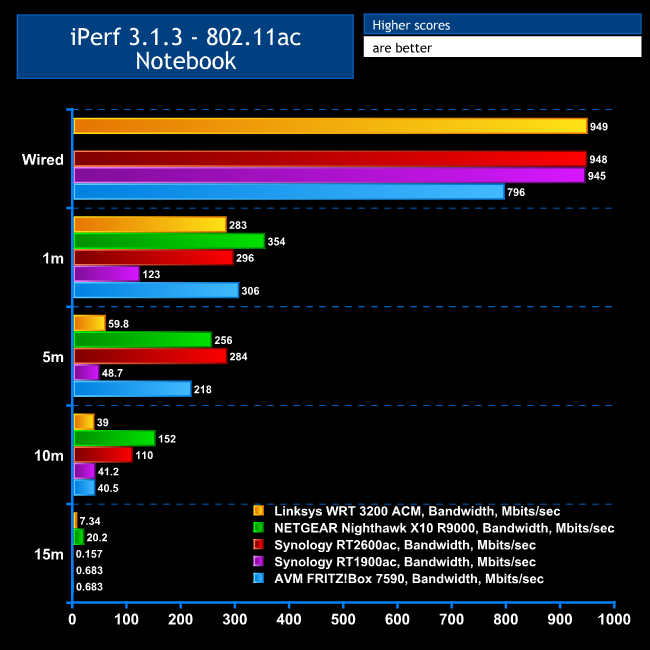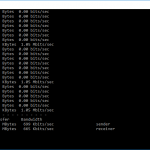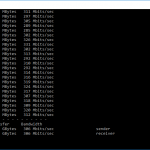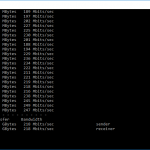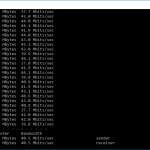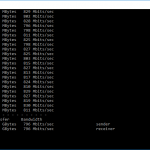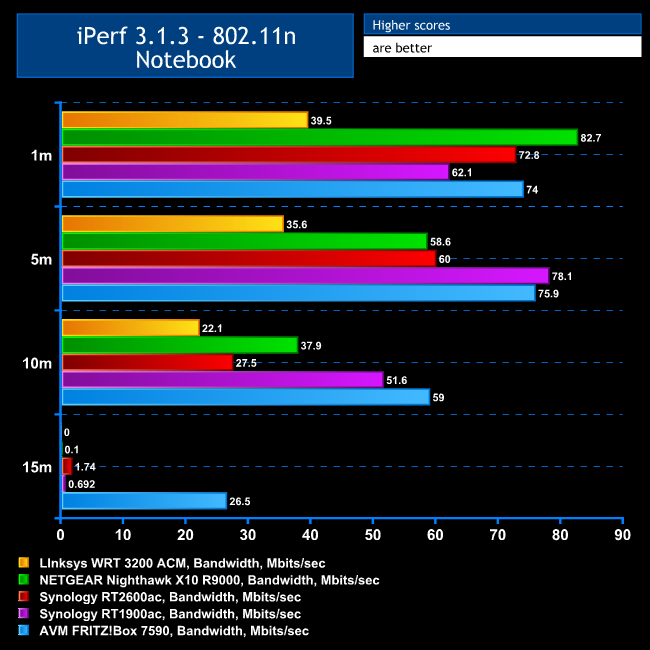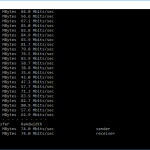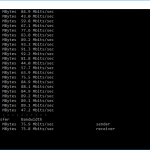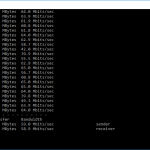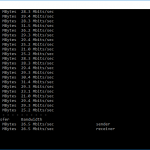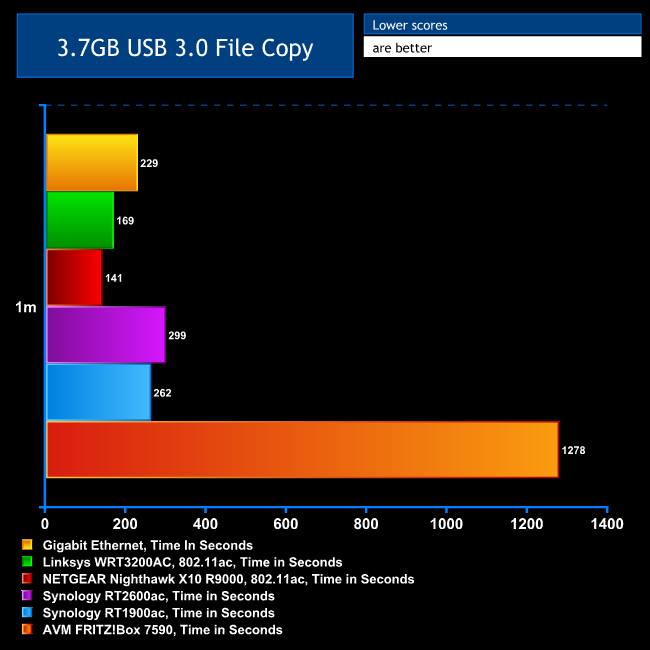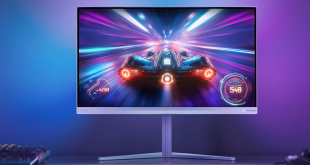We tested the AVM FRITZ!Box in two ways. First, we wanted to assess the raw throughput across the two different WiFi standards it supports – 802.11ac and 802.11n. We also tested the speed of the USB 3.0 port via a Gigabit Ethernet port and 802.11ac.
For the first test we used the open-source iPerf 3.1.3 software, and for the second test we used a 3.7GB file collection (actually the Windows 10 installer) on a SanDisk Ultra USB 3.0 thumb drive. Three Windows systems were used. One was an Armari AMD Threadripper workstation, another an HP Spectre 13 X2 notebook, and a third an HP Folio 3 notebook. All three were running Windows 10.
For all tests, the workstation was connected to one of the 7590's Gigabit Ethernet ports, and the notebooks via various WiFi connections (802.11ac for the Spectre 13, 802.11n for the Folio 13). The notebooks were then placed in four different locations – within 1m of the router, approximately 5m away with a wall in between, 10m away and on a lower floor (with multiple walls and a floor in between), and then 15m away on the same lower floor.
We tested all four distances with the two WiFi standards. You can see the distances and placements we used in more detail in our comprehensive Ultimate Mesh WiFi Router Shootout.
With each WiFi standard and distance, we took 60 readings of throughput at one second intervals and calculated the average (iPerf does this automatically). We tested the 7590 against the Synology RT1900ac and RT2600ac, Linksys WRT3200ACM and NETGEAR's Nighthawk X10 R9000.
802.11ac 5GHz
The 7590 managed only reasonable results with 802.11ac. The direct connection, shown here as a control, was a little slower than the comparisons, but we were using a different notebook for this (the HP Folio 13). The 796Mbits/sec bandwidth over Gigabit Ethernet shows that there is no bottleneck from the wired connections.
At 1m range, the 1,733Mbits/sec of potential 5GHz bandwidth shows its ability, with the 306Mbits/sec of real-world performance second only to NETGEAR's Nighthawk X10 R9000. At 5m, results are still good, although the Synology RT2600ac pushes the AVM's 218Mbits/sec into third place. Things go noticeably downhill at 10m, although 40.5Mbits/sec is still very usable, albeit well behind the NETGEAR and Synology RT2600ac. Like most routers, the 7590 isn't reaching 15m effectively.
802.11n 2.4GHz
Performance with 802.11n is a sea change over 802.11ac. The bandwidth of 74Mbits/sec is second fastest at 1m after the NETGEAR Nighthawk X10 R9000, although the Synology RT2600ac isn't far behind.
At 5m, however, bandwidth has actually improved to 75.9Mbits/sec, although this still places second. At 10m, the 7590 manages 59Mbits/sec, cruising into a clear lead, which it maintains with 26.5Mbits/sec at 15m. Clearly, the 7590 has much better range with 802.11n than 802.11ac.
USB 3.0 File Copy
For this test, we hooked up a 32GB SanDisk Ultra USB 3.0 Flash Memory key to the 7590's USB 3.0 port and configured it as network storage. We then copied the 3.7GB Windows 10 installer ISO (unpacked into individual files) to the HP Spectre 13 X2 via 802.11ac, with the notebook at a 1m distance. We also performed the file copy to the HP Folio 13 over Gigabit Ethernet (the Spectre 13 X2 doesn't have an Ethernet LAN port).
Performance was surprisingly bad. We retested this a number of times and achieved similar results. Although the file copy was managing around 4MB/sec at its fastest, which is enough for video streaming, this result does slightly reduce the 7590's NAS pretensions, despite its clear features in this area. Note that the wired file copy isn't that fast either, implying that the raw USB 3.0 bandwidth isn't as great as some routers.
Overall, the FRITZ!Box 7590 provides merely reasonable performance. Its 802.11ac speed is good at close range, and its 802.11n speed great at any range. But the file copy results are a worry for some applications.
 KitGuru KitGuru.net – Tech News | Hardware News | Hardware Reviews | IOS | Mobile | Gaming | Graphics Cards
KitGuru KitGuru.net – Tech News | Hardware News | Hardware Reviews | IOS | Mobile | Gaming | Graphics Cards


